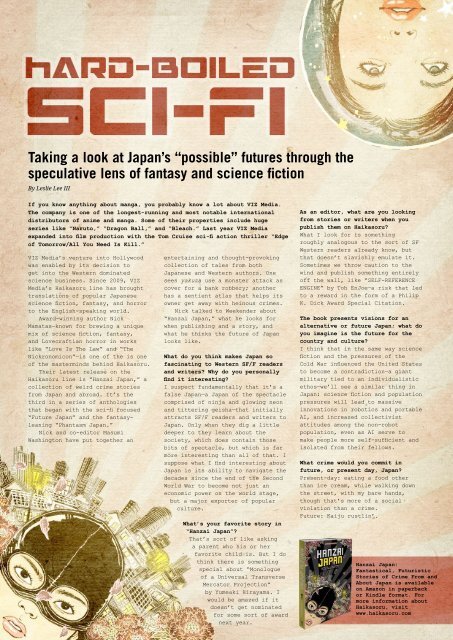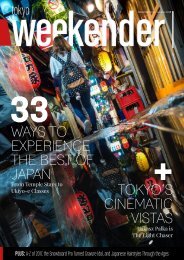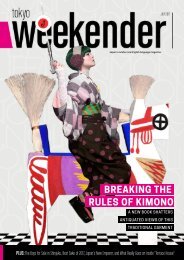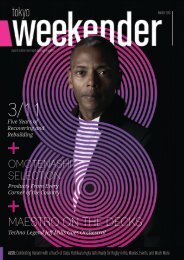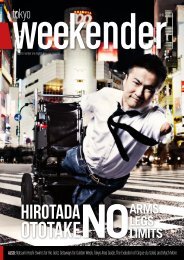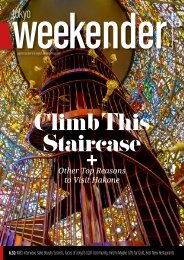Tokyo Weekender - January 2016
Looking back at the year that was. How to Stay True to Your Resolutions Snowboarding & Skiing in Honshu.
Looking back at the year that was. How to Stay True to Your Resolutions Snowboarding & Skiing in Honshu.
You also want an ePaper? Increase the reach of your titles
YUMPU automatically turns print PDFs into web optimized ePapers that Google loves.
Taking a look at Japan’s “possible” futures through the<br />
speculative lens of fantasy and science fiction<br />
By Leslie Lee III<br />
If you know anything about manga, you probably know a lot about VIZ Media.<br />
The company is one of the longest-running and most notable international<br />
distributors of anime and manga. Some of their properties include huge<br />
series like “Naruto,” “Dragon Ball,” and “Bleach.” Last year VIZ Media<br />
expanded into film production with the Tom Cruise sci-fi action thriller “Edge<br />
of Tomorrow/All You Need Is Kill.”<br />
VIZ Media’s venture into Hollywood<br />
was enabled by its decision to<br />
get into the Western dominated<br />
science business. Since 2009, VIZ<br />
Media’s Haikasoru line has brought<br />
translations of popular Japanese<br />
science fiction, fantasy, and horror<br />
to the English-speaking world.<br />
Award-winning author Nick<br />
Mamatas—known for brewing a unique<br />
mix of science fiction, fantasy,<br />
and Lovecraftian horror in works<br />
like “Love Is The Law” and “The<br />
Nickronomicon”—is one of the is one<br />
of the masterminds behind Haikasoru.<br />
Their latest release on the<br />
Haikasoru line is “Hanzai Japan,” a<br />
collection of weird crime stories<br />
from Japan and abroad. It’s the<br />
third in a series of anthologies<br />
that began with the sci-fi focused<br />
“Future Japan” and the fantasyleaning<br />
“Phantasm Japan.”<br />
Nick and co-editor Masumi<br />
Washington have put together an<br />
entertaining and thought-provoking<br />
collection of tales from both<br />
Japanese and Western authors. One<br />
sees yakuza use a monster attack as<br />
cover for a bank robbery; another<br />
has a sentient atlas that helps its<br />
owner get away with heinous crimes.<br />
Nick talked to <strong>Weekender</strong> about<br />
“Hanzai Japan,” what he looks for<br />
when publishing and a story, and<br />
what he thinks the future of Japan<br />
looks like.<br />
What do you think makes Japan so<br />
fascinating to Western SF/F readers<br />
and writers? Why do you personally<br />
find it interesting?<br />
I suspect fundamentally that it’s a<br />
false Japan—a Japan of the spectacle<br />
comprised of ninja and glowing neon<br />
and tittering geisha—that initially<br />
attracts SF/F readers and writers to<br />
Japan. Only when they dig a little<br />
deeper to they learn about the<br />
society, which does contain those<br />
bits of spectacle, but which is far<br />
more interesting than all of that. I<br />
suppose what I find interesting about<br />
Japan is its ability to navigate the<br />
decades since the end of the Second<br />
World War to become not just an<br />
economic power on the world stage,<br />
but a major exporter of popular<br />
culture.<br />
What’s your favorite story in<br />
“Hanzai Japan”?<br />
That’s sort of like asking<br />
a parent who his or her<br />
favorite child is. But I do<br />
think there is something<br />
special about “Monologue<br />
of a Universal Transverse<br />
Mercator Projection”<br />
by Yumeaki Hirayama. I<br />
would be amazed if it<br />
doesn’t get nominated<br />
for some sort of award<br />
next year.<br />
As an editor, what are you looking<br />
from stories or writers when you<br />
publish them on Haikasoru?<br />
What I look for is something<br />
roughly analogous to the sort of SF<br />
Western readers already know, but<br />
that doesn’t slavishly emulate it.<br />
Sometimes we throw caution to the<br />
wind and publish something entirely<br />
off the wall, like “SELF-REFERENCE<br />
ENGINE” by Toh EnJoe—a risk that led<br />
to a reward in the form of a Philip<br />
K. Dick Award Special Citation.<br />
The book presents visions for an<br />
alternative or future Japan; what do<br />
you imagine is the future for the<br />
country and culture?<br />
I think that in the same way science<br />
fiction and the pressures of the<br />
Cold War influenced the United States<br />
to become a contradiction—a giant<br />
military tied to an individualistic<br />
ethos—we’ll see a similar thing in<br />
Japan: science fiction and population<br />
pressures will lead to massive<br />
innovations in robotics and portable<br />
AI, and increased collectivist<br />
attitudes among the non-robot<br />
population, even as AI serve to<br />
make people more self-sufficient and<br />
isolated from their fellows.<br />
What crime would you commit in<br />
future, or present day, Japan?<br />
Present-day: eating a food other<br />
than ice cream, while walking down<br />
the street, with my bare hands,<br />
though that’s more of a social<br />
violation than a crime.<br />
Future: Kaiju rustlin’.<br />
Hanzai Japan:<br />
Fantastical, Futuristic<br />
Stories of Crime From and<br />
About Japan is available<br />
on Amazon in paperback<br />
or Kindle format. For<br />
more information about<br />
Haikasoru, visit<br />
www.haikasoru.com<br />
www.tokyoweekender.com JANUARY <strong>2016</strong>


